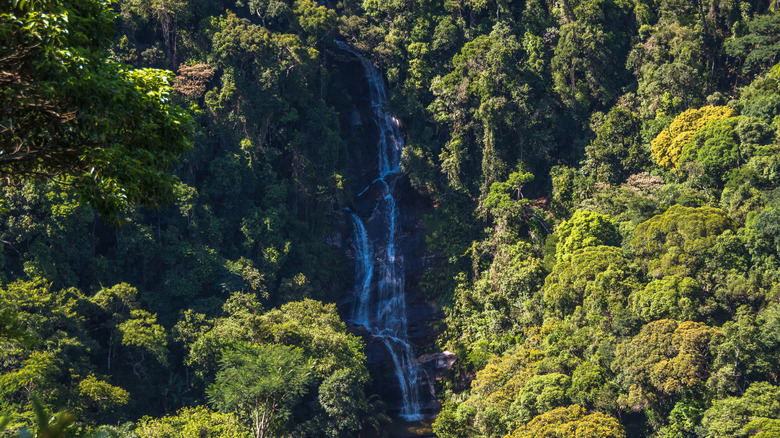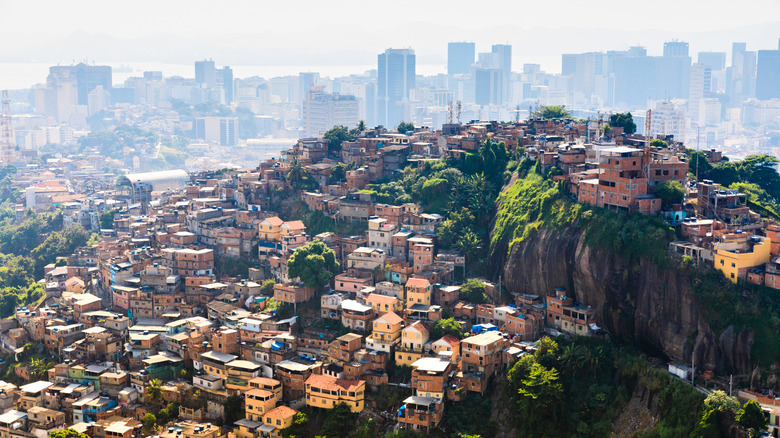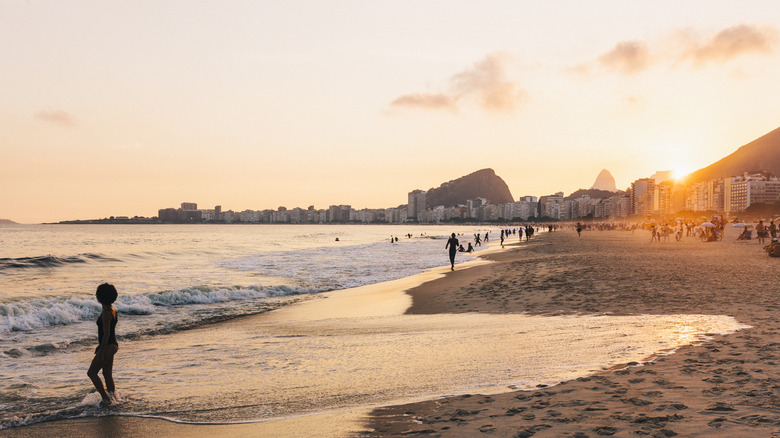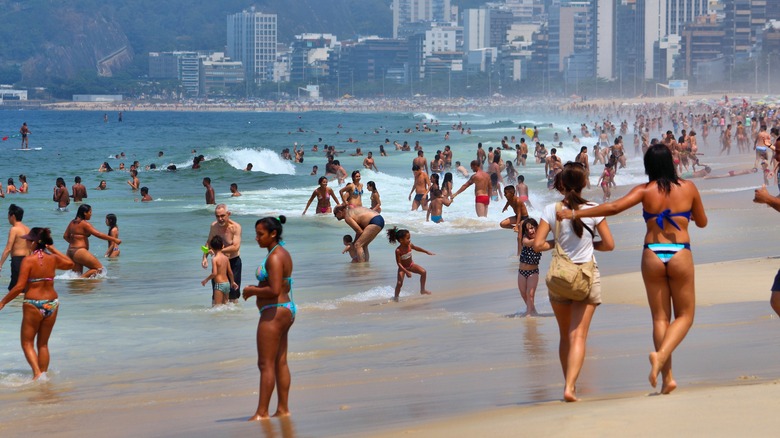Destinations Central and South America
Zigres/Shutterstock
Amelia Glean
Keep all your valuables on you

Starting right at the top, never take a purse full of cash, your passport, or any other precious items out with you for the day in Rio. It makes it exceedingly obvious that you’re a tourist, and unfortunately, pickpocketing isn’t unheard of in this city, not to mention stories of muggings.
One of the only ways to be sure you’re keeping your valuables safe at the beach is to pack the bare bones of what you need and have your wits about you. This might look like having just enough cash to get you a taxi or bus to the center (as well as a few drinks while you’re there) and keeping your phone hidden, with everything else locked up in a safe back at your accommodation. That way, you’re less likely to draw attention to yourself, but if you do get stopped, you won’t have to hand over your entire life’s savings.
Leaving your towel at home is another way to make sure you don’t stand out in Rio. It might sound strange, but Cariocas (a name given to locals) don’t use them for lying on the sand. Instead, they prefer a canga (a sarong), but only to help them dry off after a dip in the sea. Feel like fitting in? You could do worse than buying one of these from a store in the city.
Don expensive clothes

Since we’re on the topic of making sure you don’t stand out like a sore thumb, it’s much better to leave all of your designer apparel, fancy jewelry, and shiny watches at home, too. We’re not in the business of telling you how to curate your wardrobe, but labeling yourself as a tourist in Rio isn’t exactly a good idea. Yes, thieves will probably take more of a liking to you, but you’ll often be charged tourist taxes on the sly for food, excursions, and transport. And that isn’t much fun.
So, while you may have every intention of scrubbing up well on nights out or for day trips to the beach, think twice about taking that new 14-carat gold necklace out for a spin or donning the beautiful but expensive mini dress you bought especially for the occasion. Instead, you’re much better off going super casual — Rio is a beach city, after all. We’re talking flip flops and basic beach bum attire like baggy tees and shorts, and you’ll do just fine.
Use just one bank account

Wirestock/Getty Images
Before you jet off to the samba-fuelled nightlife and powdery white-sand beaches of Rio de Janeiro, think carefully about your money situation. More importantly, devise a plan for how you will withdraw your daily cash. There have been reports of skimming devices being used to hack bank accounts in Rio, which is when thieves attach something to the ATM card entry point and install a hidden camera to watch as you key in your details. Sometimes, these are even set up in public places, including supermarkets and airports. The software can read your card details as soon as you withdraw cash at an ATM, allowing thieves to empty your account when you’re done.
To limit the chance of this happening, or at least reduce how much money can be stolen from you, make sure you have more than one account set up. This might look like keeping the bulk of your funds in a savings account and using a checking account (from the same bank) for your daily expenditures. It would mean getting into the habit of only transferring a small amount of money to your checking account each time you need to withdraw cash, but this can be done easily with online banking. It sounds like a bit of a hassle, but if you’re ever the victim of a bank account hacking, “future you” will be eternally grateful.
Limit yourself to the south zone

Nature’s Charm/Shutterstock
You’ll most likely find yourself staying in the southern zone when you get to Rio, which is close to Christ the Redeemer and the famous Sugarloaf Mountain, not to mention Copacabana Beach. This is all well and good, but don’t make the mistake of missing out on some of the city’s key hidden gems beyond these big hitters. It will give you a chance to break away from the throngs of tourists at every turn and offer a much more authentic Brazilian experience while you’re at it.
Let’s start with an alternative selection of beaches — a drumroll, please, for Rio’s secluded tropical shorelines in Joatinga Beach and Praia Vermelha (Red Beach). The former is a magical spot where surfers glide in and out of the waves, and the latter’s red-tinged sand and craggy cliffs welcome paddle boarders and kayak lovers. Perhaps you’d prefer a glistening waterfall? Make your way to the world’s largest urban forest in Tijuca Forest National Park to glimpse the dazzling 115-foot-high Taunay Waterfall. Although you aren’t allowed to bathe in its crystal clear waters, it makes for magnificent pictures.
But if neither of these hideaways tickles your fancy, Rio has plenty of hiking trails to keep you busy. Bico do Papagaio is the ultimate viewpoint, which can also be found inside Tijuca Forest. Okay, it’s not a hike for the faint-hearted — with some climbing involved — but its rewarding views make it well worth the effort.
Visit a favela on your own

Cokada/Getty Images
You’ve probably seen the scores of vibrant, colorful houses piled on top of each other in Rio, often precariously perched on a cliff’s edge. These are the iconic favelas, with over 1,000 scattered across the city. In fact, some favela neighborhoods look remarkably similar to a movie set somewhere on Italy’s Amalfi coast. But a word of caution here — otherwise known as slums or shanty towns, much of Rio’s reputation for violence and gangs was born out of the favela areas, which are often considered to be a dangerous South American destination worth skipping.
As a tourist, it’s not recommended to go wandering around these on your own. But if you’d like to scratch beneath the city’s surface and be given a chance to understand how local people live, you can book an organized walking tour. Many operators will take you to the famous Rocinha — the largest favela in Latin America — while others may focus their attention on Vidigal. Once notorious for its violence and drug lords, the latter is now safe for visitors, having been pacified by the police in the lead-up to two major international sporting events in Rio — the FIFA World Cup in 2014 and the Summer Olympics in 2016. We should mention that there is some controversy around favela tours — namely that much of the generated revenue doesn’t go to poverty-stricken residents living in these areas, but it’s an option to consider.
Explore the beach at night

Travel_motion/Getty Images
A romantic beachside walk after dark is one of life’s true pleasures, especially on those heady summer nights. But you’ll want to think twice about it in Rio — many areas of Copacabana Beach and the shores of Ipanema and Leblon aren’t well-lit at this time, making them the perfect base for drug trafficking, mugging, petty thieves, and bag snatchers. There are a handful of stories where locals have appeared over-friendly with tourists and tried to sell them drugs. In the instances when tourists have taken them up on this offer, it’s often led to being caught and bribed by a policeman, who was in on the whole thing from the start!
Much of these unfortunate happenings tend to occur closer to the water, where it’s much darker, rather than around the well-lit kiosks and huts selling nightcaps on the beach’s edge. With all this in mind, use your common sense and avoid these areas after sunset to steer clear of any trouble. If you’re concerned, you could always ask the reception staff at your hotel. They can give you peace of mind by helping you work out which beaches are the safest to visit.
Rely on the police

Alexandre Rotenberg/Shutterstock
We’ve touched on this a little bit already, but it’s worth going into more detail. The police in Rio are unlikely to be similar to the forces you’re used to back home. During the day, they patrol the streets and dress like they mean business, but if you go to them with a case of petty theft — say your mobile phone has been stolen or you’ve been pickpocketed — they may well just turn you away or briskly shrug you off. This is because both scenarios happen multiple times a day in Rio, and in many cases, police are more focused on what’s considered to be serious acts of crime — drug trafficking and violence.
What’s more, at the times when you’d most expect police to be on guard (at night and in and around the city’s beaches), they’re often nowhere to be found. This is just another reason to avoid coastal areas after dark or walk anywhere on your own, if you can help it.
Eat only at Copacabana’s restaurants

Gmvozd/Getty Images
You’ll likely be staying in and around Copacabana for your one-in-a-lifetime trip to Rio. If you are, do us a favor; don’t spend every waking minute of your time here. Granted, the beach is a must-visit, the area is one of the safest spots for tourists to frequent, and you can bag great seafood, but its beachfront restaurants charge eye-watering prices, and the food is nowhere near as authentic or tantalizing as the tastes you can savor elsewhere. Interested? Centro is the place to be, with local favorites Angu do Gomes, Escondidinho, and Antigamente serving up hearty, traditional Brazilian fare.
Barbecue (otherwise known as churrasco) should be first on your list, particularly the succulent slow-cooked ribs. But there’s so much more to the country’s culinary roots, including feijoada (a delicious black bean and pork stew) and dried meat with cassava — a starchy local root vegetable. Not to mention the street food delight of crunchy, deep-fried pastels bursting with mouthwatering fillings. Oh, and if you have a sweet tooth, you’ll want to sample those deliciously fudgy coconut kisses to round everything off.
Expect everyone to speak English

Fg Trade/Getty Images
If you’re backpacking your way across the Banana Trail in Southeast Asia, interrailing with friends through Central and Eastern Europe, or holidaying in Australia and New Zealand, there’s a good chance you’ll get through most of it by only speaking English. This isn’t the case in South America, and especially not in Brazil. Here, the native tongue is Portuguese, and it pays to know a few local phrases.
So, before you jet off, make it your mission to get to grips with the new language, or at the very least, the beginnings of one. It can help you engage with locals, talk to taxi drivers about directions, and order food, not to mention really help you out if something were to go wrong. Brazilians are usually a very smiley and hug-happy bunch — in fact, it’s often considered the most friendly country in South America. Nonetheless, trying your hand at the local language will go a long way, while refusing to stray from English is a surefire way to irritate local people.
Go topless

Tupungato/Shutterstock
Rio’s beaches are very often full to the brim with locals wearing teenie-tiny string bikinis or tight-fitted, barely-there swim trunks. It might surprise you then to hear that going topless isn’t a thing here, especially on Copacabana Beach. At best, it’s frowned upon and will scream “tourist” to anyone nearby, but at worst, you’re opening yourself up to potential problems with the police. Besides, there is nothing wrong with tanlines.
Having said that, if you are a “free the nipple” kind of girl or a “whip your clothes off” kind of guy, Praia de Abricó is the beach for you — you’ll find it nestled in the western zone of Rio, and around 75 minutes by car from Copacabana. As the only stretch of sand that welcomes naturists in the city, it gets pretty busy, with long, snaking traffic jams to and from its shores. To avoid this, you’re much better off setting out for the beach in the early morning or delaying your trip until late afternoon.
Visit Christ the Redeemer at the weekend

Donatas Dabravolskas/Shutterstock
Rio isn’t always the cheapest city to fly into, so you might not have that much of a say about which day you’ll arrive and whether your trip straddles a Friday, Saturday, or Sunday. But it’s much better to avoid visiting the city’s famous sites during the weekend if you can help it. Going against this advice means you’re signing up for a long day standing in the stifling Brazilian sun (or very strong UV rays poking through the clouds) with queues — lots of queues.
For a much more pleasurable atmosphere and experience, hit the likes of Christ the Redeemer and Sugarloaf Mountain during the week, when the swathes of crowds have thinned out — typically outside the hours of 10 a.m. and 3 p.m. But if you really can’t avoid the weekend, go as early in the morning as you dare. The first funicular ride for Christ the Redeemer sets off at 8 a.m. Likewise, the earliest you can get up to Sugarloaf Mountain is 8:30 a.m., with the final cable car boarding at 6:30 p.m. Oh, and don’t forget to take sunscreen, whatever you do!
Miss out on samba

PeopleImages.com – Yuri A/Shutterstock
Few experiences are as quintessentially Rio as samba. In fact, samba is the lifeblood of the city, drawing on a myriad of rhythmic beats typical of Brazilian music, much of which originated from Afro-Brazilian communities in the late 19th century. Think percussion instruments, an emphasis on melody, effortless harmonies, and mesmerizing dancers. All of this is to say that if Rio is your next stop, you can’t leave without catching some live samba and boogying along — if you’re brave enough.
One of the best neighborhoods for dance clubs (many of which go on all night) is lively Lapa. It’s often referred to as the cultural district of Rio, thanks in part to the famous Lavradio Market, colorful Selarón steps, and the Romanesque Carioca Aqueduct. But the nightlife here is where it’s at — Beco do Rato is the number one club to visit if you want a traditional samba experience, while Rio Scenarium is arguably the most beautiful. We’re talking antique furniture, jaw-dropping works of art, and spectacular samba performed in a concert-style hall.
Get into an argument about Brazilian football

A.RICARDO/Shutterstock
From seductive samba to skillful soccer (or futebol as the Cariocas call it) — one of the biggest don’ts on this list is to mouth off about Brazilian futebol, unless you come with glowing compliments, of course. Brazilians, especially those in Rio, are an incredibly passionate bunch, and the sport is practically a religion here — from the minute you arrive, you’ll see that it’s played out in all corners of the city, not to mention on every ounce of its powdery-white sand beaches.
Then there’s Rio’s Maracanã Stadium, a footballing temple and one that’s played host to some of the most iconic sporting matchups in history. Talking of the greats, it’s in your best interest to concede that Pelé, Neymar, and Kaká are the best players of all time. Forget about your appreciation for Argentina’s Maradona and Leo Messi or Portugal’s Cristiano Ronaldo. If you’re looking for bonus points, bring up the name of any random Brazilian player from the past, and the conversation will flow. Oh, and while you’re at it, leave out the fact that Brazil’s national team hasn’t won any major trophies in a while. In short, when in Rio, it’s a good idea to keep all your footballing theories to yourself.

